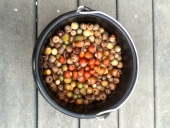
 4
4




When you reach your lowest point, you are open to the greatest change.
-Avatar Aang
 4
4




 1
1




 3
3




Whatever it takes to dodge a time clock.
 2
2




A human being should be able to change a diaper, plan an invasion, butcher a hog, conn a ship, design a building, write a sonnet, balance accounts, build a wall, set a bone, comfort the dying, take orders, give orders, cooperate, act alone, solve equations, analyze a new problem, pitch manure, program a computer, cook a tasty meal, fight efficiently, die gallantly. Specialization is for insects.
-Robert A. Heinlein
 2
2




When you reach your lowest point, you are open to the greatest change.
-Avatar Aang
 5
5




Whatever it takes to dodge a time clock.
 1
1




 1
1




 5
5




Zone 5/6
Annual rainfall: 40 inches / 1016 mm
Kansas City area discussion going on here: https://www.facebook.com/groups/1707573296152799/




A human being should be able to change a diaper, plan an invasion, butcher a hog, conn a ship, design a building, write a sonnet, balance accounts, build a wall, set a bone, comfort the dying, take orders, give orders, cooperate, act alone, solve equations, analyze a new problem, pitch manure, program a computer, cook a tasty meal, fight efficiently, die gallantly. Specialization is for insects.
-Robert A. Heinlein
 1
1




Dan Grubbs wrote:A friend of mine keeps goats and chickens in a large movable pen. This pen has a winch powered by a 12v battery connected to a solar panel. The winch is set on a cheap timer to turn on every so often and pull in the cable which is staked out far away from the pen. The net effect is the pen is automatically moved to new grass on a timer and my friend doesn't have to touch it except to move the stake and pull out the winch cable to restart the whole process again. This keeps the goats on fresh grass without having all the labor of moving the large pen. He's been running this for nearly two years now. He has the timing dialed down after a short trial-and-error period. Daily fresh milk and eggs from animals that are grazing on new grass all day. Pretty sweet set up, actually.
 3
3





Zone 5/6
Annual rainfall: 40 inches / 1016 mm
Kansas City area discussion going on here: https://www.facebook.com/groups/1707573296152799/
 2
2








When you reach your lowest point, you are open to the greatest change.
-Avatar Aang
 4
4




 1
1




James Landreth wrote:The pictures are great. Wes, does Salatin go into more detail about this? Was this mentioned in one of his books?
 1
1




When you reach your lowest point, you are open to the greatest change.
-Avatar Aang
 9
9




![Filename: 20180218_111605-640x480.jpg
Description: [Thumbnail for 20180218_111605-640x480.jpg]](/t/75843/a/58455/20180218_111605-640x480.jpg)
Sometimes the answer is nothing

 3
3




When you reach your lowest point, you are open to the greatest change.
-Avatar Aang
 5
5




Sometimes the answer is nothing

 2
2




When you reach your lowest point, you are open to the greatest change.
-Avatar Aang
 2
2




Sometimes the answer is nothing

 2
2




Sometimes the answer is nothing

 2
2




When you reach your lowest point, you are open to the greatest change.
-Avatar Aang
 2
2




Sometimes the answer is nothing

 2
2




A human being should be able to change a diaper, plan an invasion, butcher a hog, conn a ship, design a building, write a sonnet, balance accounts, build a wall, set a bone, comfort the dying, take orders, give orders, cooperate, act alone, solve equations, analyze a new problem, pitch manure, program a computer, cook a tasty meal, fight efficiently, die gallantly. Specialization is for insects.
-Robert A. Heinlein
 2
2




James Landreth wrote:Hi Taylor,
I don't really have much experience with electric fencing. How would I go about figuring out what to get? Would calling that Premier 1 work? It's something to think about. I'd prefer to develop a system that I can be more self-sufficient on maintaining and fixing, but maybe electric netting is something I should consider
 1
1




wayne fajkus wrote:Look at what i saw today
![Filename: 20190531_183828-1-.jpg
Description: Another view of the same hill. I feel like such a hypocrite having all that grass with no sheep [Thumbnail for 20190531_183828-1-.jpg]](/t/75843/a/78931/thumb-20190531_183828-1-.jpg)
 2
2




Sometimes the answer is nothing

 3
3




 3
3




Sometimes the answer is nothing

 5
5




Sometimes the answer is nothing

 2
2




 2
2




wayne fajkus wrote:I just looked at the pen. I'm guessing 20ft x 20ft. The babies like to run and buck. Its too cute. That space is adequate for that. The adults do run, but mainly to get away from something. I think 2-3 sheep in that pen with fresh grass would be happy.
What about a ram? What about breeding? Any plans for that? One of the things people dont think about is birthing. Like i have 2 female cows and 1 bull. I go full circle(birth to slaughter). The 3 become 5, then 7 before 2 goes to slaughter bringing it back to 5. Cycle keeps repeating. People plan for the 3, not the 7. Thats when things get out of hand.
 5
5




Sometimes the answer is nothing

 3
3




Sometimes the answer is nothing

 2
2




Standing on the shoulders of giants. Giants with dirt under their nails
 1
1




A piece of land is worth as much as the person farming it.
-Le Livre du Colon, 1902
 1
1




Standing on the shoulders of giants. Giants with dirt under their nails

|
Don't go into the long grass, or the tiny ads will get you.
The new gardening playing cards kickstarter is now live!
https://www.kickstarter.com/projects/paulwheaton/garden-cards
|




